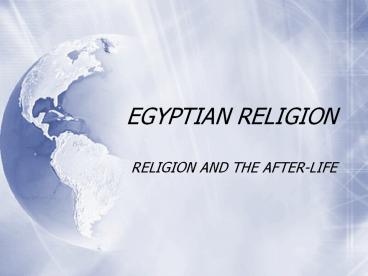EGYPTIAN RELIGION - PowerPoint PPT Presentation
1 / 29
Title:
EGYPTIAN RELIGION
Description:
EGYPTIAN RELIGION RELIGION AND THE AFTER-LIFE Ancient Egyptian Religion Religion guided every aspect of Egyptian life. Egyptian religion was based on polytheism, or ... – PowerPoint PPT presentation
Number of Views:434
Avg rating:3.0/5.0
Title: EGYPTIAN RELIGION
1
EGYPTIAN RELIGION
- RELIGION AND THE AFTER-LIFE
2
Ancient Egyptian Religion
- Religion guided every aspect of Egyptian life.
- Egyptian religion was based on polytheism, or the
worship of many deities. - The Egyptians had as many as 2000 gods and
goddesses, but only a few were worshipped by all
Egyptians.
3
Ancient Egyptian Religion
- Many gods and goddesses were represented as part
human and part animal. - For example, Horus, the sky god, had the head of
a hawk, and body of a human. - They considered animals such as the bull, the
cat, and the crocodile to be holy.
4
Ancient Egyptian Religion
- Their two chief gods were Amon-Ra and Osiris.
- Amon-Ra was believed to be the sun god and the
lord of the universe. - Osiris was the god of the dead and the
necropolis.
5
Ancient Egyptian Religion
- The Egyptian "Book of the Dead" contains the
major ideas and beliefs in the ancient Egyptian
religion. - Because their religion stressed an afterlife,
Egyptians devoted much time and wealth to
preparing for survival in the next world.
6
Major Gods and Goddesses
- Anubis
- Osiris
- Ra
- Horus
- Hathor
7
Anubis-God of Mummification and Death
8
Osiris- God of The Underworld King of Dead
9
Ra-God of Sun Supreme Judge
10
Horus-Sky God or Falcon God
11
Hathor-Goddess of
Love, Birth, Death, Music, Pleasure
Shown as Women with horned head dress or a Cow
12
Hathor-as a cow
13
Death and Funerals
- The Egyptians saw death as a transitional stage
in the progress to a better life in the next
world. - Egyptians were resurrectionists, they believed
each persons soul would return to the body and
they would live again in the afterlife. - Therefore, it was essential for the body to
survive intact.
14
Mummification
- Funerals were very expensive.
- A person would need to
- 1. Have a tomb carved out of solid rock.
- 2. Gather all necessary objects to place in
the tomb. - 3. Appoint their son or a priest to bring an
offering for the deceased daily for up to one
year.
15
Mummification
- Mummification was a long and expensive process.
The expense of mummification limited the full
procedure to the very rich. - For the poor, a shallow grave near the desert was
common. The dry, hot climate caused natural
mummification to occur. - But all wanted to insure their journey into the
afterlife.
16
THE TOMB
17
The Tomb in Ancient Egypt
- The tombs were created to provide the dead with a
place to store the necessary supplies needed in
the journey to the afterlife. - Inside the tombs clothing, jewelry, food, and
weapons were stored, all placed there as supplies
for the afterlife.
18
A BOAT FOR THE AFTERLIFE-FROM KING TUTS TOMB
19
The Tomb in Ancient Egypt
- In addition to the material in the tomb, the
walls of the tomb where painted with scenes from
every day life. - As shown on the next slide.
20
(No Transcript)
21
The Tomb in Ancient Egypt
- Before the body is laid to rest, a burial mask
would be placed over the mummified body. - The most famous burial mask was found the in tomb
of King Tut (shown on next slide).
22
TUTS GOLDEN MASK
23
Journey into the After Life
- The journey into the afterlife was a difficult
one. - To help, scripts would be left with magical
spells to help the deceased navigate through the
afterlife.
24
Journey into the After Life
- These scripts became known as the "Book of the
Dead." - The spirit would begin it's journey by crossing a
wide river and then pass through a gate guarded
by monsters.
25
The Judgement-copied from Tuts Tomb
26
Journey into the After Life
- The deceased then would have to go to the "Hall
of Two Truths" to be judged. - The person would be brought before a tribunal of
the gods and be accused of forty-two different
crimes each charge dealing with one event in the
dead persons life. He would have to answer the
charges.
27
Journey into the After Life
- After successfully answering these charges, his
heart would be put on a scale and weighed against
a feather. - If the heart is found to be lighter then the
feather, true and without sin the person would
be allowed into the afterlife.
28
Journey into the After Life
- If the heart was not lighter then the feather, a
monster with the head of a crocodile, the body
of a lion and hippo would immediately devour
the heart. - Without a heart, the person would have no memory
or personality and no chance for eternal life.
29
Journey into the After Life
- Egyptians believed the afterlife to be an eternal
never-ending time of leisure no labor and
pleasure. - Life there would be much better than anything on
earth--except possible being pharaoh.























![[DOWNLOAD]⚡️PDF✔️ Kingship and the Gods: A Study of Ancient Near Eastern Religion as the Integra PowerPoint PPT Presentation](https://s3.amazonaws.com/images.powershow.com/10050481.th0.jpg?_=20240607124)







